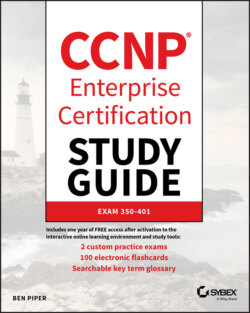Читать книгу CCNP Enterprise Certification Study Guide: Implementing and Operating Cisco Enterprise Network Core Technologies - Ben Piper, David Higby Clinton - Страница 84
Summary
ОглавлениеAs with any networking technology, practice and experience are going to do more to solidify your conceptual understanding of Spanning Tree than simply studying it. Be sure to work through the exercises at the end of this chapter until you feel comfortable completing them on your own without referencing anything else.
Having your VLANs and trunks set up properly is a prerequisite for configuring or troubleshooting Spanning Tree. A VLAN must be configured on a switch before a Spanning Tree instance can exist for it. And for multiple switches to participate in Spanning Tree for a VLAN, they need to have trunks with the VLAN allowed and active.
The most common Spanning Tree mode you'll encounter is RPVST+. It goes by a variety of names, including RSTP and 802.1w. Two things that make for a rapid convergence time are what set it apart from the original PVST+: the absence of timer-based port states and the introduction of link types.
MST is useful when you have a large number of VLANs. Rather than using RPVST+, which creates a separate Spanning Tree instance for each VLAN, MST lets you map multiple VLANs to a single instance.
